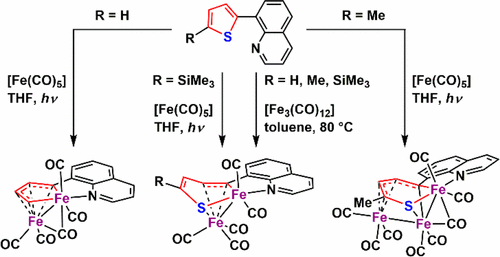当前位置:
X-MOL 学术
›
Organometallics
›
论文详情
Our official English website, www.x-mol.net, welcomes your
feedback! (Note: you will need to create a separate account there.)
Carbon–Sulfur Bond Cleavage Reactions of Quinolyl-Substituted Thiophenes with Iron Carbonyls
Organometallics ( IF 2.5 ) Pub Date : 2017-06-01 00:00:00 , DOI: 10.1021/acs.organomet.7b00280 Takumi Matsunaga 1 , Isamu Kinoshita 1 , Masakazu Hirotsu 1
Organometallics ( IF 2.5 ) Pub Date : 2017-06-01 00:00:00 , DOI: 10.1021/acs.organomet.7b00280 Takumi Matsunaga 1 , Isamu Kinoshita 1 , Masakazu Hirotsu 1
Affiliation

|
Thermal reactions of quinolyl-substituted thiophenes (2-(8′-quinolyl)thiophene (QT), 2-methyl-5-(8′-quinolyl)thiophene (MeQT), 2-(8′-quinolyl)-5-(trimethylsilyl)thiophene (TMSQT)) with [Fe3(CO)12] gave the corresponding thiolate-bridged diiron complexes [Fe2(μ-LR)(CO)5] (R = H, Me, SiMe3), where LH, LMe, and LTMS are dianionic N,C,S-tridentate ligands (SC(R)CHCHC(Q)2–, Q = 8-quinolyl) formed by the oxidative addition of the C–S bond in QT, MeQT, and TMSQT, respectively. In contrast, the formation of photoreaction products of the quinolyl-substituted thiophenes with [Fe(CO)5] was dependent on the R group of the thiophene ring. The photoreaction of QT gave the sulfur-free diiron complex [Fe2{CHCHCHC(Q)}(CO)5], whereas the photoreactions of MeQT and TMSQT gave the thiolate-bridged triiron complex [Fe3(μ-LMe)(CO)8] and diiron complex [Fe2(μ-LTMS)(CO)5], respectively, as the major products. In the triiron complexes [Fe3(μ-LR)(CO)8], an Fe(CO)3 unit is bound to the C(R)CHCH moiety in the S-metallacycle of the diiron complexes [Fe2(μ-LR)(CO)5]. The difference in the photoreaction products is described on the basis of the reactivity of the thiolate complexes [Fe2(μ-LR)(CO)5] and [Fe3(μ-LR)(CO)8]. Although the photoreactions of the diiron complexes [Fe2(μ-LR)(CO)5] with [Fe(CO)5] produced the corresponding triiron complexes [Fe3(μ-LR)(CO)8], desulfurization leading to the formation of [Fe2{CHCHCHC(Q)}(CO)5] was predominant for R = H, and a fast conversion of the triiron complex to a CO elimination product was observed for R = SiMe3.
中文翻译:

喹啉基取代的噻吩与铁羰基的碳硫键裂解反应
喹啉基取代的噻吩(2-(8'-喹啉基)噻吩(QT),2-甲基-5-(8'-喹啉基)噻吩(MeQT),2-(8'-喹啉基)-5-(三甲基硅烷基)噻吩(TMSQT)),与的[Fe 3(CO)12 ],得到相应的硫醇盐,桥接二铁配合物的[Fe 2(μ-L - [R )(CO)5 ](R = H,Me中,森达3),其中L H,L Me和L TMS是通过QT中C–S键的氧化加成形成的阴离子N,C,S-三齿配体(SC(R)CHCHC(Q)2–,Q = 8-喹啉基) ,MeQT和TMSQT。相反,喹啉基取代的噻吩与[Fe(CO)的光反应产物的形成5 ]取决于噻吩环的R基团。QT的光反应,得到无硫二铁配合物的[Fe 2 {CHCHCHC(Q)}(CO)5 ],而MeQT和TMSQT的光反应,得到硫醇盐桥联三铁配合物的[Fe 3(μ-L我)( CO)8 ]和二铁配合物的[Fe 2(μ-L TMS)(CO)5 ],分别作为主要产品。在三铁配合物的[Fe 3(μ-L - [R )(CO)8 ],将Fe(CO)3在二铁配合物[Fe的S-金属环单元被结合到C(R)CHCH部分2(μ -L [R)(CO)5 ]。根据硫醇盐络合物[Fe 2(μL· R)(CO)5 ]和[Fe 3(μL· R)(CO)8 ]的反应性来描述光反应产物的差异。虽然二铁配合物[Fe的光反应2(μ-L - [R )(CO)5 ]与[铁(CO)5 ]中产生的相应的三铁配合物的[Fe 3(μ-L - [R )(CO)8 ],脱硫导致形成[Fe 2 {CHCHCHC(Q)}(CO)5对于R = H是最主要的],并且对于R = SiMe 3,观察到三铁配合物快速转化为CO消除产物。
更新日期:2017-06-02
中文翻译:

喹啉基取代的噻吩与铁羰基的碳硫键裂解反应
喹啉基取代的噻吩(2-(8'-喹啉基)噻吩(QT),2-甲基-5-(8'-喹啉基)噻吩(MeQT),2-(8'-喹啉基)-5-(三甲基硅烷基)噻吩(TMSQT)),与的[Fe 3(CO)12 ],得到相应的硫醇盐,桥接二铁配合物的[Fe 2(μ-L - [R )(CO)5 ](R = H,Me中,森达3),其中L H,L Me和L TMS是通过QT中C–S键的氧化加成形成的阴离子N,C,S-三齿配体(SC(R)CHCHC(Q)2–,Q = 8-喹啉基) ,MeQT和TMSQT。相反,喹啉基取代的噻吩与[Fe(CO)的光反应产物的形成5 ]取决于噻吩环的R基团。QT的光反应,得到无硫二铁配合物的[Fe 2 {CHCHCHC(Q)}(CO)5 ],而MeQT和TMSQT的光反应,得到硫醇盐桥联三铁配合物的[Fe 3(μ-L我)( CO)8 ]和二铁配合物的[Fe 2(μ-L TMS)(CO)5 ],分别作为主要产品。在三铁配合物的[Fe 3(μ-L - [R )(CO)8 ],将Fe(CO)3在二铁配合物[Fe的S-金属环单元被结合到C(R)CHCH部分2(μ -L [R)(CO)5 ]。根据硫醇盐络合物[Fe 2(μL· R)(CO)5 ]和[Fe 3(μL· R)(CO)8 ]的反应性来描述光反应产物的差异。虽然二铁配合物[Fe的光反应2(μ-L - [R )(CO)5 ]与[铁(CO)5 ]中产生的相应的三铁配合物的[Fe 3(μ-L - [R )(CO)8 ],脱硫导致形成[Fe 2 {CHCHCHC(Q)}(CO)5对于R = H是最主要的],并且对于R = SiMe 3,观察到三铁配合物快速转化为CO消除产物。


















































 京公网安备 11010802027423号
京公网安备 11010802027423号